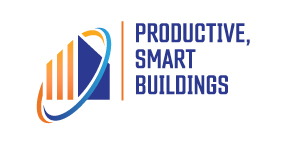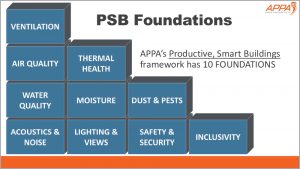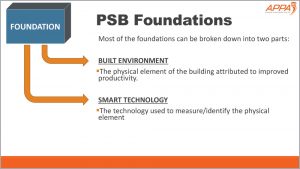

With the rising cost of energy and the push to decarbonize, a facility manager is faced with a complex trilemma: to reduce operational costs, improve operational effectiveness, and maximize the occupant experience all at the same time! In many situations, financial pressures prioritize the reduction in both capital and operational costs and therefore take precedence over the focus on the productivity of human capital for both the facilities manager and the occupant. The considerable degradation of human productivity that has resulted from of a lack of tangible measures is mostly invisible, though it depends on the type of human activity being measured and the nature of the cost-saving measures being implemented. A creditable and straightforward decision-making framework that balances the tangible and intangible benefits should help solve this imbalance.

The smart building framework, properly applied through innovations in both technology and not-for-profit business models, can achieve cost savings and should not result in a loss of human productivity. Specifically, smart building technologies allow us to achieve three seemingly mutually exclusive goals:
- optimize building conditions for increasing productivity during occupancy;
- maximize efficiency and occupant experience cost-effectively; and
- provide continuous monitoring and control of environmental conditions inside buildings for better human interactions.
To address this challenging trilemma, APPA’s Productive, Smart Buildings initiative quantifies how productive our built environment is and how facility managers are leveraging smart technologies to continuously monitor, measure, and enable that productivity. Productive, Smart Buildings is a free self-assessment decision-making framework to optimize human productivity by investing in the built environment and smart technologies.
The Productive, Smart Buildings initiative is based on the “9 Foundations of a Healthy Building” identified in the book Healthy Buildings: How Indoor Spaces Can Make You Sick–or Keep You Well (Allen & Macomber, 2022) and a 10th foundation, Inclusivity. In alignment with the intentional national focus on diversity, equity, and inclusion (DEI), this 10th foundation ensures that facilities management teams, as C-suite influencers, are at the forefront of the DEI conversation.
Productive, Smart Buildings Foundations:
- Ventilation
- Air Quality
- Thermal Health
- Water Quality
- Moisture
- Dust and Pests
- Acoustics and Noise
- Lighting and Views
- Safety and Security
- Inclusivity
Each of these foundations includes elements that will measure and corroborate the impact of both the built environment element and, in most cases, a smart building technology element.
For example:
- The built environment element of the Thermal Health foundation includes an assessment of a building’s ability to maintain the temperature in occupied spaces at the optimal level for everyone’s productivity. “Thermal health” references the way the temperature of the interior space drives or detracts from productivity. If you have ever tried to work in an office that’s too cold or too hot, it’s all you can concentrate on.
- The smart technology element quantifies if there are sensors and controls in those occupied spaces to continuously monitor and manage deviations. In addition, using occupancy sensing smart technologies can help reduce cost and energy consumption by automatically reducing ventilation and/or increasing temperature tolerance.
While the industry has marketed ways to identify a building’s energy efficiency and sustainability and allows facilities managers to obtain “certifications,” these come at a high cost to organizations whose budgets are already tight. APPA’s Productive, Smart Buildings is a first-of-its-kind self-assessment framework that allows senior facilities officers to quickly prioritize investments in the built environment by meaningfully engaging other departmental leadership from information technology, the financial office, and central administration to aid in decision making.
APPA engaged a pilot group of volunteer institutions to complete the Productive, Smart Buildings framework for 3–10 buildings on their campuses. Read the companion article, Productive, Smart Buildings: Pilot Program Results. The volunteers for the pilot group provided valuable validation feedback to the task force, which was incorporated into the framework.
Download the Productive, Smart Buildings framework.
Learn more about APPA’s Productive, Smart Buildings initiative.
 Create an Account
Create an Account
 Login/myAPPA
Login/myAPPA
 Bookstore
Bookstore
 Search
Search  Translate
Translate